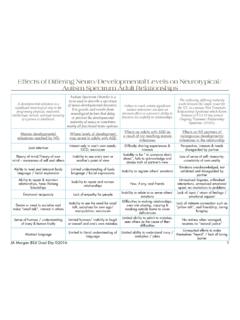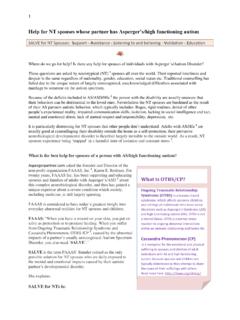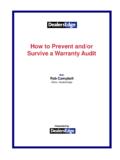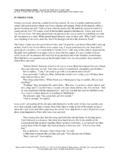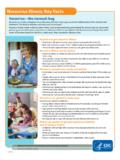Transcription of HONOURING RESISTANCE - FAAAS
1 HONOURING . RESISTANCE . How Women Resist Abuse in Intimate Relationships Table of Contents HONOURING RESISTANCE | Page 1. Acknowledgements .. 2. Introduction .. 3. Definitions .. 5. Types of abuse by perpetrators .. 6. Susan's Story .. 8. Whenever people are badly treated, they always resist .. 17. People tend not to notice that victims resist abuse .. 22. Perpetrators know that victims will resist, so they make plans to try to stop the victim's RESISTANCE .. 25. Abusive and violent behaviour is always done deliberately .. 26. When it comes to domestic violence, appearances are deceiving .. 28. Conclusion .. 30. Copies of this handbook are available from: Calgary Women's Emergency Shelter Box 52051 Edmonton Trail Calgary, Alberta T2E 8K9. Phone: (403) 539-5141. Email: Fax: (403) 237-7728. Page 2 | HONOURING RESISTANCE Acknowledgements The Calgary Women's Emergency Shelter (CWES) would like to thank the following individuals who originated the ideas and the response- based approach put forward in this handbook: s Dr.
2 Alan Wade, , Private Practitioner, Duncan, BC. s Nick Todd, C. Psych., former Coordinator of the Men's Crisis Service, Calgary Women's Emergency Shelter s Dr. Linda Coates, , University of Lethbridge This handbook was originally written in 2005, entitled RESISTANCE to Violence and Abuse in Intimate Relationships - a response-based perspective, by the following people, who were staff of the Calgary Women's We believe Emergency Shelter at that time: perpetrators can, at any s Jill Weaver, , s Nick Todd, , C. Psych. point in time, s Cindy Ogden, , choose to change s Laura Craik, , and to behave This version of the handbook was revised from respectfully the original in 2007. towards others The printing of this booklet was made possible through the generous support of the United Way. Introduction HONOURING RESISTANCE | Page 3. The concepts presented in this handbook were developed by a group of professionals who have worked in the field of domestic violence for many years.
3 This handbook was written for: s women who have experienced domestic violence;. s the friends and family who love them;. s professionals who work in the field of domestic violence; and s perpetrators of domestic violence By reading this handbook, our hope is that: s women will recognize the strength they have shown in resisting abuse;. s friends and family of abused women will have a better understanding of the many subtle ways women resist abuse;. s professionals counselling victims and/or perpetrators of domestic violence will use the response-based approach;. s perpetrators will choose to consistently treat their partners with respect and dignity. Many people believe victims of domestic violence share some common effects of abuse by their intimate partners. They make an assumption that victims passively accept violence, and lack self-esteem, assertiveness, or boundaries. Much attention is paid to these effects of violence.
4 Unfortunately, this leads people to have a stereotyped, negative view of victims. This handbook looks at what victims do when they are being abused. By looking at what victims do to oppose abuse and to keep their dignity, we hope people will form a more accurate view of victims. We also hope victims will reconsider any feelings they are damaged , and, instead, to look at the strengths they have shown in resisting abuse. This handbook also looks at what perpetrators do when they are abusive. Much attention is focused on trying to understand the reasons people are abusive. For example, it has been suggested that perhaps people are abusive because they themselves were abused as children, or they have mental health disorders. Unfortunately, this sometimes leads to excusing Page 4 | HONOURING RESISTANCE perpetrators from responsibility for their behaviour. In fact, it is our experience in working with perpetrators that they are in control of their actions, and that they make deliberate choices about their abusive behaviour.
5 We believe perpetrators can, at any point in time, choose to change and to behave respectfully towards others. In working in the field of domestic violence, we have found that: 1) Whenever people are badly treated, they always resist. In our experience, people always resist violence and abuse in some way. They will stand up against, not comply with, and try to stop or prevent violence, disrespect, or oppression. 2) People tend not to notice that victims resist abuse. Abuse can be very dangerous, so usually victims resist it in ways that are not obvious. Others probably will not even notice the RESISTANCE so they assume that victims are passive and they do not do enough to stand up for themselves. In fact, victims actively resist violence, and in real life, the so-called passive victim does not exist. 3) Perpetrators of violence know that victims will resist, so they make plans to stop the victims from resisting.
6 For instance, some women will resist their husband's abuse by leaving the house. Knowing this, some men will try to stop this RESISTANCE by taking shoes, money, bank cards and car keys. Others might pull the phone out of the wall to prevent their wives from calling for help. 4) Violent and abusive behavior is always done deliberately. As shown in point 3 above, the fact that perpetrators make plans to stop victims from resisting indicates that their abuse is deliberate. Perpetrators also make decisions about how they will be abusive. For example, some men think it is wrong to hit a woman , but they will push, grab and verbally abuse their partners. 5) When it comes to domestic violence, appearances are deceiving. HONOURING RESISTANCE | Page 5. Onlookers cannot easily see what occurs in domestic violence situations. Typically, perpetrators and victims do not tell others what is happening. Perpetrators cover up their abusive behaviour.
7 They may blame the victim and be friendly and charming to the outside world, so that they do not have to face the consequences of their actions. Victims do not often like to tell the full story of the abuse to others, because 1) it may not be safe to do so and 2) they do not want people to think negatively of them. We will explain more about these ideas in the rest of this handbook. First, we will define some of the words we use in this handbook. We also describe different types of abuse. We will then share one woman's story of her husband's abuse. This story helps to show how she resisted abuse, and how these ideas apply to a real-life situation. DEFINITIONS. Abuse: deliberate behavior in which one person chooses to dominate, control, or harm another. Perpetrators abuse against the will of victims, who never ask or choose to be abused. Perpetrator: the person in a close relationship who chooses to behave in ways that harm, control, or dominate another.
8 Victim: the person who has been purposely harmed by the unwanted actions of another. The victim is in no way responsible for the abusive actions of another. Victims always oppose abuse and often show great strength in doing so. RESISTANCE to Abuse: Whenever people are abused, they do many things to oppose the abuse and to keep their dignity and their self-respect. This is called RESISTANCE . The RESISTANCE might include not doing what the perpetrator wants them to do, standing up against, and trying to stop or prevent violence, disrespect, or oppression. Imagining a better life may also be a way that victims resist abuse. ** Note: in this handbook, we are using she' to describe the victim, and he' to describe the perpetrator, because in our women's shelter, most of Page 6 | HONOURING RESISTANCE our clients have been in heterosexual relationships in which they have been abused by men. However, sometimes women within heterosexual relationships can be abusive towards men.
9 Within lesbian relationships they can sometimes be abusive towards other women. Homosexual men can also be abusive towards their partners. TYPES OF ABUSE BY PERPETRATORS. Here are just a few examples of behaviours that are abusive: Emotional or psychological abuse: s . insults; name calling; belittling; constant criticisms;. s . attacking a person's belief system or culture;. s . abusing or neglecting children and attempting to stop the mother from intervening;. s . mocking the victim; humiliating her;. s . using the victim's lack of legal rights to get more power and control over her. ( People in common-law relationships or in homosexual relationships, as well as immigrants without citizenship status, are examples of people who have not been granted full legal rights.). Isolation: s trying to stop the victim from having access to family and/or friends;. s trying to stop her from having social contacts, outside interests, and/.
10 Or work;. s jealousy; taking away her access to a vehicle or transportation. Intimidation: s destruction of property;. s attempting to control what a person says or does not say;. s attempting to make the victim account for every minute of her day;. s threatening to hurt anyone who helps the victim;. s threatening to hurt or kill children, pets, friends, or family;. s threatening to commit suicide;. s attempting to control with fear;. s telling her she is a bad mom;. s threatening to be abusive if she does not do what he wants;. s threatening to disclose the victim's sexual orientation if she does not do what the perpetrator wants. HONOURING RESISTANCE | Page 7. Economic abuse: s keeping his money from the family; trying to stop the victim from earning money;. s attempting to force her to hand over money;. s attempting to force her to account for how she spends money;. s forcing the family to live in poverty when money is available.
